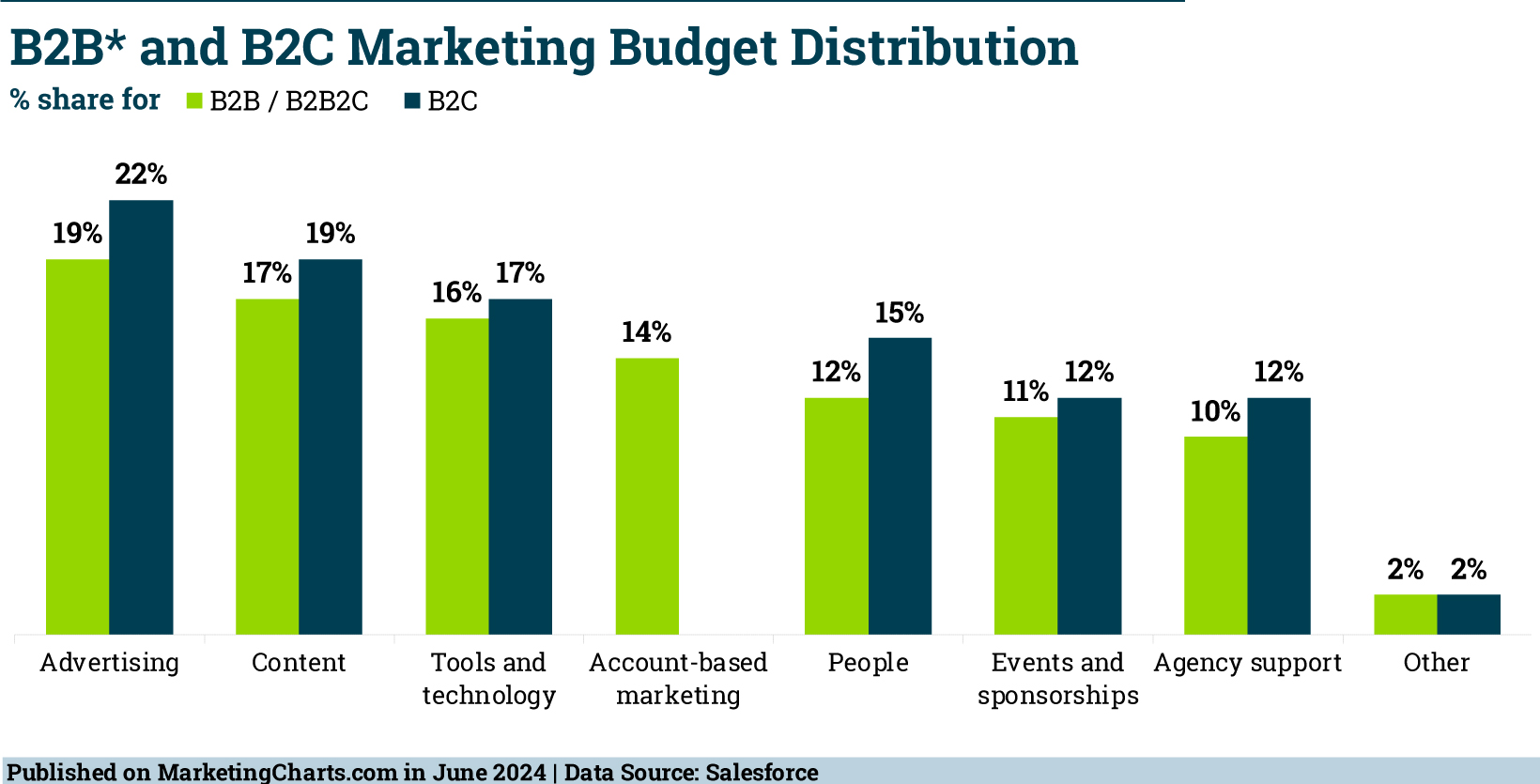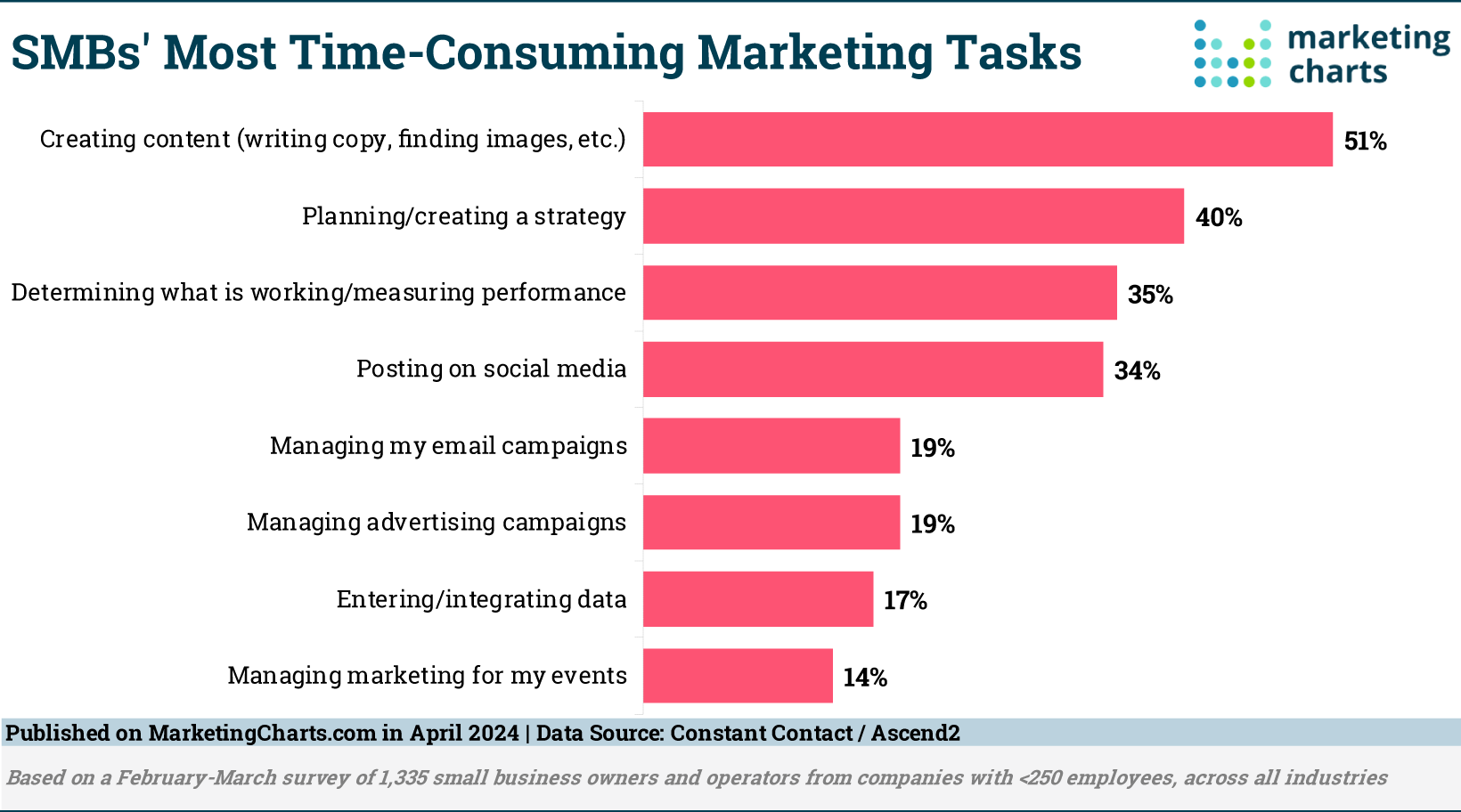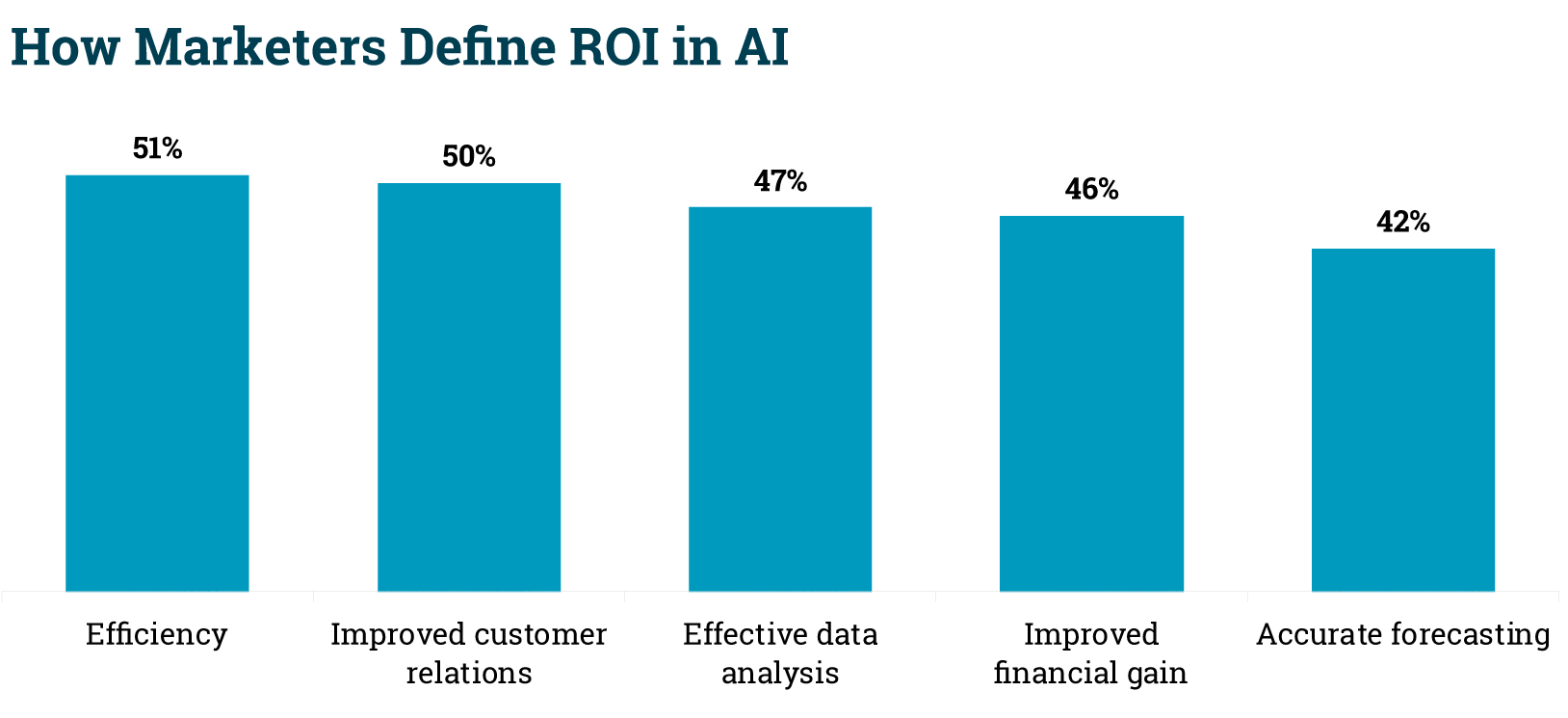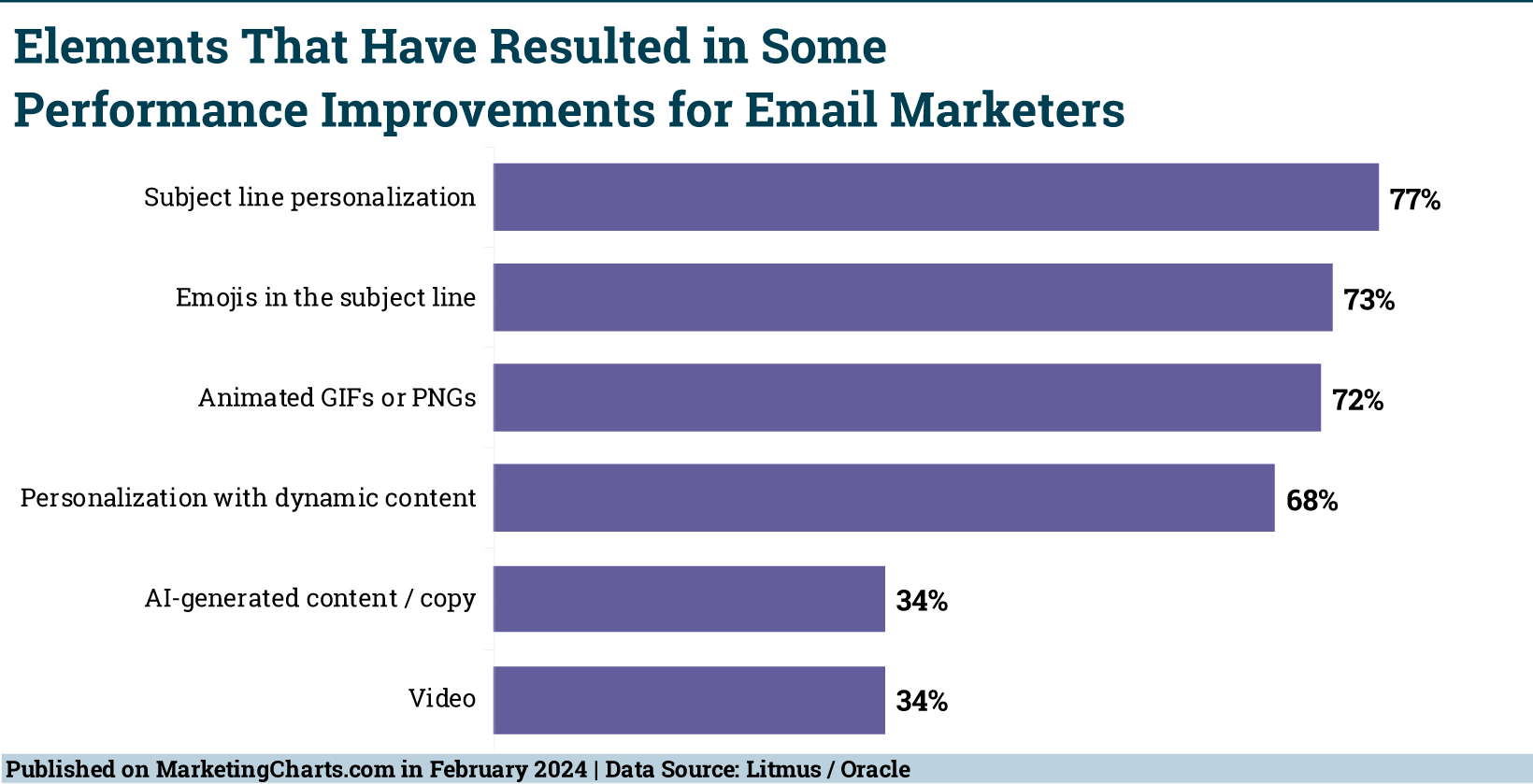![How Marketing Dollars Are Distributed [Report]](https://bersondeanstevens.com/wp-content/uploads/2024/06/MarketingDistrib_6.24-1080x630.jpg)
by Lori Berson | Jun 25, 2024 | Marketing, Marketing Strategy
In the latest analysis of marketing budgets, advertising has emerged as the largest expenditure for marketers worldwide. According to Salesforce’s State of Marketing report, B2B and B2C marketers allocate more of their budgets to advertising than any other resource. This trend underscores the critical role of paid media in reaching and engaging target audiences effectively.

Key Findings
- Budget Allocation: B2B marketers allocate 19% of their budgets to advertising, while B2C marketers allocate an even higher 22%. This marks an increase from 2022, with ad spend rising by 3% for B2B and 4% for B2C marketers.
- Comparison with Other Expenses: In contrast, spending on agency support has decreased, now at 10% for B2B and 12% for B2C marketers. This suggests a shift in priorities towards direct advertising efforts.
- Content and Technology: Content remains a significant expenditure, accounting for 17% of B2B budgets and 19% of B2C budgets. Additionally, tools and technology claim 16% and 17% of the budgets for B2B and B2C marketers, respectively.
Gartner’s research aligns with these findings, noting an increase in paid media’s share at the expense of marketing technology, agencies, and labor since 2018.
Tools in Use
Marketers are utilizing an average of eight different tools and technologies, with marketing analytics/measurement tools (88%), customer relationship management systems (86%), and ad platforms (80%) being the most common.
Account Based Marketing (ABM)
B2B and B2B2C marketers allocate 14% of their budgets to account-based marketing (ABM). Interestingly, B2B marketers report a focus on customer acquisition (60%), product-led growth (48%), and upselling (48%), rather than solely on deepening relationships with existing customers.
Customer Focus
Among B2B respondents, 78% market to accounts, 65% to opportunities, and 64% to leads. However, the primary use of ABM is for new customer acquisition rather than maintaining existing relationships.
The trend towards increased ad spend indicates a shift in how marketers are prioritizing their budgets. As the digital landscape evolves, marketers are investing more in direct advertising methods, leveraging various tools to optimize their campaigns and reach their target audiences effectively. This focus on paid media underscores its growing importance in the marketing mix and the strategic adjustments marketers are making to stay competitive.
Data: The results are based on a global survey of 4,850 marketers across B2B (25%), B2C (50%), and B2B2C (25%) business models. Some 39% held the role of CMO (12%), VP or equivalent (27%).
Need assistance with your marketing strategy? To get started, schedule a call or email Lori at lberson@BersonDeanStevens.com.
BersonDeanStevens has been a recognized brand strategy and marketing leader for over 25 years. We work in partnership with you to differentiate your brand and achieve your business goals. Client list.

by Lori Berson | May 29, 2024 | AI, artificial intelligence, Marketing, Marketing Strategy
Generative AI (GenAI) is quickly transforming marketing, enabling content creation, decision automation, and data-driven insights. Adopting it promises competitive advantages, as major companies actively explore and implement GenAI solutions. However, realizing GenAI’s full potential requires a strategic, well-planned implementation approach. Here are several key considerations to keep in mind.
Assess Your Readiness
Before adopting GenAI, honestly evaluate if your organization is ready. This goes beyond just having the technology. Your use of GenAI must align with your overall business goals. Do you have enough staff and funding? Are roles and processes clearly defined? Many companies lack combined AI and marketing expertise, so you may need to bring in outside talent.
Build a Data-Driven Culture
GenAI relies on high-quality data for accurate outputs. Companies should develop strong data practices around governance, quality control, and privacy. Treating data as a strategic asset, rather than an afterthought, will pay off for GenAI and overall decision-making. A comprehensive data strategy is essential.
Tailor Use Cases
Don’t just adopt generic GenAI solutions. Identify your real marketing needs that GenAI can address. Get input and buy-in from employees across different teams. Use cases should be customized to your unique challenges and opportunities. Make sure to gather continuous feedback and maintain transparent ethical standards when building solutions.
Plan for Scalability
While pilot projects prove concepts, GenAI’s true value comes from wide-scale deployment across the organization. Market leaders get more productivity, quality, and creativity gains from scalable implementations. Design your use cases to smoothly integrate into all marketing operations. Robust change management prepares everyone for the transformation.
Manage Risks
GenAI introduces new risks around compliance and cybersecurity. You should adhere to AI governance frameworks like NIST’s AI RMF and the EU AI Act. And implement “security-by-design” via practices like penetration testing to address AI’s unique cybersecurity risks.
Assess Expertise
GenAI’s implementation requires skills that blend AI and data science with deep marketing know-how. Since this skill set remains scarce, companies should supplement staff with fractional or contract marketing experts who can provide specialized leadership and cross-functional guidance throughout the implementation journey.
With careful strategy and preparation, GenAI can drive innovation, operational efficiencies, and a sustained competitive advantage. Those who get it right will be well-positioned to thrive in this exciting new era of data-driven, AI-enabled marketing.
Ready to integrate AI into your marketing? To get started, download our tip sheets and schedule a call or email Lori at lberson@BersonDeanStevens.com.
BersonDeanStevens has been a recognized brand strategy and marketing leader for over 25 years. We work in partnership with you to differentiate your brand and achieve your business goals. Client list.

by Lori Berson | May 15, 2024 | Marketing, Marketing Strategy
In a recent study by Constant Contact and Ascend2, roughly 39% of small and medium-sized businesses (SMBs) across the US, UK, Australia, and Canada are increasing their marketing budgets this year. This uptick in spending is not just about spending more; it’s about strategically expanding marketing efforts to include a wider selection of channels and tactics. In fact, over 40% of SMBs are set to diversify their marketing channels and tactics, recognizing the need to adapt to a rapidly changing market environment.

This expansion means businesses will need to dedicate more time to their marketing strategies. Currently, most SMBs spend less than an hour per day on marketing, focusing their energies instead on essential business operations such as customer interactions and order fulfillment. However, as marketing budgets increase, 44% of SMBs anticipate that more of their time will be allocated to marketing endeavors.
Despite the intention to ramp up marketing efforts, a significant challenge remains: many SMBs (52%) regularly delay or postpone marketing activities, often due to time constraints. Content creation, strategy planning, and social media posts are particularly susceptible to delays. These tasks are not only time-consuming but also require specific marketing knowledge that many SMBs lack. This knowledge gap often confines them to familiar and easy-to-implement channels, potentially limiting growth.
Advantages of Fractional Marketers
To overcome these challenges and effectively use their increased budgets, SMBs can benefit from hiring fractional marketers. Fractional marketers are experienced professionals who offer their expertise on a part-time or contract basis. Here are several key benefits of bringing fractional marketers on board:
- Expertise on Demand: Fractional marketers bring specialized knowledge and skills that may be missing internally. They can strategize, execute, and measure the effectiveness of various marketing tactics, filling the knowledge gap without the cost of a full-time hire.
- Cost Effectiveness: Hiring a fractional marketer is more affordable than employing a full-time senior marketing executive. SMBs can access top-tier talent while staying within budget, ensuring that increased marketing investments deliver maximum impact.
- Flexibility and Scalability: As SMBs expand their marketing efforts, they need flexible strategies that can scale with their growth. Fractional marketers can adjust their involvement based on the company’s current needs and budget, providing more support during strategic launches or scaling back during slower periods.
- Fresh Perspectives: Bringing in a fractional marketer can inject new ideas and perspectives into the business, which can be crucial for innovation and staying ahead of market trends.
- Time Management: By delegating substantial marketing responsibilities to a fractional marketer, business owners can free up their time to focus on core business operations and customer engagement, optimizing the productivity of the business as a whole.
As SMBs prepare to increase their marketing budgets to capture larger audiences and enhance their market share, hiring fractional marketers offers a strategic advantage. These professionals not only mitigate the challenges of time and expertise but also enable SMBs to maximize their marketing ROI, ensuring that every dollar spent contributes to significant business growth.
About the Data: The results are based on a February-March survey of 1,335 small business owners and operators representing companies with fewer than 250 employees, across all industries.
Ready to elevate your marketing strategy without the overhead of a full-time executive? Schedule a call or email Lori at lberson@BersonDeanStevens.com to discover how fractional marketing services can drive your business forward.
BersonDeanStevens has been a recognized brand strategy and marketing leader for over 25 years. We work in partnership with you to differentiate your brand and achieve your business goals. Client list.

by Lori Berson | Apr 18, 2024 | Marketing, Marketing Strategy
The role of a Chief Marketing Officer (CMO) is more critical than ever. However, not all companies can or need to onboard a full-time CMO. This is where the concept of Fractional CMOs comes into play, offering a flexible and strategic solution for businesses, particularly startups and those undergoing significant transitions.
The Rise of Fractional CMOs
A Fractional CMO is an experienced marketing professional who provides strategic leadership on a part-time basis. This model is becoming increasingly popular, providing companies with access to senior marketing expertise without the commitment of a full-time executive salary. This approach is especially beneficial for organizations at pivotal growth stages or those needing targeted project management to navigate complex marketing landscapes successfully.
Strategic Advantages of Hiring a Fractional CMO
- Expertise on Demand: Fractional CMOs bring a wealth of experience from diverse industries and backgrounds, offering fresh perspectives and innovative solutions.
- Cost Efficiency: With the ability to hire on a part-time or project basis, companies can manage budgets more effectively while still leveraging top marketing talent.
- Flexibility and Scalability: The fractional engagement allows businesses to adapt quickly to market changes and scale marketing efforts up or down based on current needs and budgets.
Potential Challenges
While the benefits are significant, there are some challenges to consider:
- Cultural Fit: A Fractional CMO might not be as embedded in the company culture, which can impact team dynamics and long-term strategy alignment.
- Divided Attention: Managing multiple clients can lead to conflicts in prioritization and focus, potentially diluting the impact on your business.
Choosing the Right Fractional CMO
Selecting the right Fractional CMO involves a strategic alignment with your company’s vision and goals. It’s crucial to define clear objectives and success metrics from the beginning and ensure regular communication and stakeholder engagement to maximize the effectiveness of the partnership.
For businesses navigating critical transformations or looking to scale efficiently without the overhead of a full-time position, a Fractional CMO is an excellent investment. By understanding both the benefits and potential pitfalls, companies can make informed decisions that align with their long-term marketing strategies and overall business objectives.
Ready to elevate your marketing strategy without the overhead of a full-time executive? Schedule a call or email Lori at lberson@BersonDeanStevens.com to discover how a Fractional CMO can drive your business forward.
For help with your marketing strategy, schedule a call or email Lori Berson at lberson@BersonDeanStevens.com.
BersonDeanStevens has been a recognized brand strategy and marketing leader for over 25 years. We work in partnership with you to differentiate your brand and achieve your business goals. Client list.

by Lori Berson | Apr 16, 2024 | AI, artificial intelligence, Data, Marketing Strategy
Marketing’s measure of success is often boiled down to a single metric: Return on Investment (ROI). However, recent research commissioned by Iterable and conducted by Wakefield Research, and published by Ad Age, suggests a shift in how marketers perceive ROI from investments in Artificial Intelligence (AI).

Efficiency and Customer Relations: The New ROI Drivers
Unlike traditional views that align ROI directly with financial gain, today’s marketers are increasingly valuing efficiency and improved customer relations as primary indicators of ROI in AI initiatives. The study reveals that 51% of marketers define ROI through the lens of efficiency gains, underscoring AI’s role in streamlining operations and enhancing productivity. Furthermore, 50% of marketers connect ROI with the improvement of customer relationships, highlighting the potential of AI to personalize customer interactions and allow for deeper connections.
Data Analysis and Forecasting: Enhancing Decision Making
While financial gains are still significant, with 46% of marketers linking ROI to improved financial outcomes, there’s a noticeable shift towards valuing the strategic advantages of AI beyond direct monetary returns. Additionally, 42% of marketers see the value of AI in providing accurate forecasting, which can be pivotal in strategic decision-making.
Marketers’ Adoption and Attitudes Towards AI
With 91% of surveyed marketers already using AI technologies, the perception of AI as a transformative force rather than just a tool is gaining traction, yet only 37% see it as an essential skill they must master, despite widespread concern about keeping up with technological advancements.
The Future of AI in Marketing: Opportunities and Challenges
This shift in perspective is not just theoretical. Marketers report that AI contributes to better job performance and operational efficiency. Most believe AI opens doors to new positions rather than replacing jobs, with 69% viewing AI as a creator of opportunities.
The shift in ROI measurement underscores a broader transition in marketing—from a purely financial focus to a multi-dimensional strategy that includes efficiency, customer relationships, and data-driven decision-making. As AI technologies continue to advance, their role in reshaping marketing strategies and defining new success metrics will undoubtedly expand, offering both challenges and opportunities for marketers aiming to stay ahead in their fields.
About the Data: The results are based on a September 2023 survey of 1,200 marketers.
For help infusing AI into your workflows, schedule a call or email Lori Berson at lberson@BersonDeanStevens.com.
BersonDeanStevens has been a recognized brand strategy and marketing leader for over 25 years. We work in partnership with you to differentiate your brand and achieve your business goals. AI use cases and client list.

by Lori Berson | Apr 3, 2024 | Email Marketing, Marketing
Email marketing remains a vital tool for businesses aiming to connect with their audience. However, the effectiveness of this tool is significantly influenced by how businesses choose to use artificial intelligence (AI) and personalization tactics. A recent Litmus report in partnership with Oracle provides an overview of the current landscape and the opportunities available with email marketing, revealing some insightful trends.

AI in Email Marketing: Underused Yet Potentially Transformative
AI-generated content and copy in email marketing, despite being a common use case, surprisingly ranks low in contributing to campaign performance improvements. This apparent underutilization is not a reflection of AI’s potential but rather indicates a nascent stage of adoption. With only one-third of marketers reporting a boost in email performance due to AI-generated content, it’s clear that those who have used generative AI are reaping significant benefits. This scenario presents a compelling opportunity for businesses to explore AI’s capabilities further and integrate them into their email marketing strategies.
The Unrivaled Impact of Personalization and Segmentation
The report highlights two critical tactics that overwhelmingly improve email marketing performance: subject line personalization and the use of emojis. An impressive 77% of email marketers have found that personalizing subject lines enhances campaign effectiveness, while 73% credit emojis with boosting performance. This data underscores the importance of crafting engaging and tailored content that resonates with the recipient, making the email more than just another message in their inbox but a personalized communication that captures their attention.
Beyond subject lines, personalization extends into the content of the emails themselves. Dynamic content, tailored to the recipient’s preferences and behaviors, has significantly increased click-through rates. This level of customization demonstrates a deep understanding of the target audience, making for a stronger connection between the brand and its customers.
Furthermore, an overwhelming 90% of surveyed email marketers acknowledged that segmentation plays a pivotal role in enhancing campaign performance. By dividing their audience into distinct groups based on specific criteria, marketers can deliver more relevant and impactful messages, thereby increasing engagement and conversion rates.
A Call to Action
The insights from the Litmus and Oracle report serve as a compelling call to action for email marketers. In an age where consumers are bombarded with digital communications, the ability to stand out through personalized, engaging, and AI-enhanced content is more crucial than ever. As email marketing continues to evolve, businesses must stay updated on these trends and leverage them to create meaningful connections with their audience. By prioritizing personalization, segmentation, and the strategic use of AI, marketers can transform their email campaigns into powerful tools for building lasting relationships and driving business success.
About the Data: The results are based on an October and November 2023 survey of more than 480 email marketers worldwide.
For help with your email marketing, schedule a call or email Lori Berson at lberson@BersonDeanStevens.com.
BersonDeanStevens has been a recognized brand strategy and marketing leader for over 25 years. We work in partnership with you to differentiate your brand and achieve your business goals. Client list.
![How Marketing Dollars Are Distributed [Report]](https://bersondeanstevens.com/wp-content/uploads/2024/06/MarketingDistrib_6.24-1080x630.jpg)








